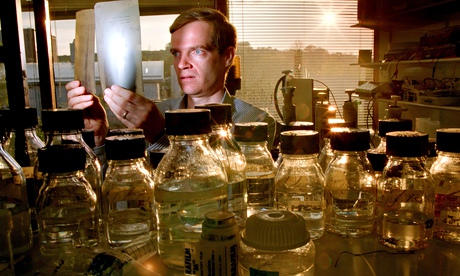Stop the deluge of science research
The increasing pace of human discovery is a curse – we need to rethink what it means to publish the results of research

Are we publishing too much scientific research? Photograph: Murdo Macleod
The rapid growth of scientific literature is often seen as
evidence, if evidence were needed, that the pace of human discovery is
accelerating. On the contrary, however, it is becoming a curse – one
that requires us to radically rethink what it means to publish the
results of research.
Relentlessly
– day after day, year after year – scientists are uncovering new facts
about the world. If anything, the startling rate at which this happens
appears to be increasing, but how would we know if such an impression
was true? One way is to look at the rate at which scientific papers are
published and these have indeed been appearing at an ever-increasing
rates for decades or even centuries.
As reported in a recent paper,
the rate of growth of cited (ie somewhat influential) scientific
publications has risen from less than 1% before the middle of the 18th
century to 2-3% in the first half of the 20th century, and 8-9% today.
That last figure is equivalent to a greater than doubling of scientific
output every decade. What better testament to human intellectual
progress and the power of the scientific method?
Not so fast. For a
start, not every publication is equal. When the author Theodore
Sturgeon first invoked his famous law ("90% of everything is crap") he
was talking about science
fiction, but he could equally well have been talking about science.
Estimates vary wildly, but probably between a quarter and a third of all research papers in the natural sciences go uncited. A much larger proportion is cited only by their own authors or by one or two others.
This
is not necessarily a sign of inadequate or wasteful research, but it
should give us pause. It is at least partly a result of the imperative
for researchers to publish in order to continue to secure funding and
employment, and the accompanying incentive to salami-slice research
results so as to secure the maximum number of publications from any
given piece of work. This in turn leads to the bane of every scientist's
existence: far too many papers to read in far too little time.
This
situation is only going to get worse, even in the absence of any
genuine increase in scientific activity. One reason is the rise of
author-pays open-access publishing. This has the benefit of allowing
anyone to read the research in question without paying the publisher,
but also has the disadvantage of giving publishers a strong commercial
incentive to issue as much content as possible.
In general I am a supporter of open access,
but subscription business models at least help to concentrate the minds
of publishers on the poor souls trying to keep up with their journals.
As
if this were not enough, proponents of open science (including me) are
proposing that researchers should start publishing all of their work –
complete with full data sets, comprehensive methods, negative results
and "failed" experiments.
In an age of bottomless digital
information this is technically achievable and has the potential to
greatly increase the transparency, impartiality and reproducibility of
research – particularly welcome at a time when science is going through
something of a crisis of confidence on these fronts. But it hardly promises a more manageable literature for those who are desperately trying to absorb all this information.
The
only practical solution is to take a more differentiated approach to
publishing the results of research. On one hand funders and employers
should encourage scientists to issue smaller numbers of more significant
research papers. This could be achieved by placing even greater
emphasis on the impact of a researcher's very best work and less on
their aggregate activity.
On the other they should require
scientists to share all of their results as far as practically possible.
But most of these should not appear in the form of traditional
scholarly papers, which are too laborious for both the author and the
reader to fulfil such a role. Rather, less significant work should be a
issued in a form that is simple, standardised and easy for computers to
index, retrieve, merge and analyse. Humans would interact with them only
when looking for aggregated information on very specific topics.
What
would such a publication look like? I don't know exactly, but we can
see signs in born-digital data publishing platforms such as Figshare (a portfolio company of Digital Science, which I run), Zenodo (an initiative from CERN, the European particle-physics laboratory) and Dryad (a not-for-profit membership organisation that supports the dissemination of research data).
It
is easy to forget that 350 years ago the scientific journal was itself
an innovation, enabled in large part by the emergence of the printing
press some 200 years earlier. Today our challenge is to create a new
kind of scientific publication, internet-enabled and fit for a data-rich
digital age.

Nenhum comentário:
Postar um comentário